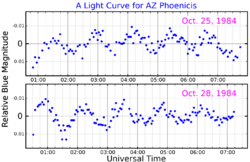Astronomy:AZ Phoenicis
| Observation data Equinox J2000.0]] (ICRS) | |
|---|---|
| Constellation | Phoenix |
| Right ascension | 00h 50m 03.77s[2] |
| Declination | −43° 23′ 41.92″[2] |
| Apparent magnitude (V) | 6.47[3] |
| Characteristics | |
| Spectral type | A9/F0III[4] |
| Variable type | δ Scuti[3] |
| Astrometry | |
| Radial velocity (Rv) | 11.9[5] km/s |
| Proper motion (μ) | RA: 6.65[2] mas/yr Dec.: 25.03[2] mas/yr |
| Parallax (π) | 10.1141 ± 0.0578[2] mas |
| Distance | 322 ± 2 ly (98.9 ± 0.6 pc) |
| Absolute magnitude (MV) | 1.65 ± 0.30[6] |
| Details | |
| Radius | 2.70[2] R☉ |
| Luminosity | 18.6+5.9−4.5[6] L☉ |
| Surface gravity (log g) | 3.78 ± 0.08[6] cgs |
| Temperature | 7,278 ± 34[6] K |
| Metallicity | [Z] = +0.52 ± 0.15[6] |
| Other designations | |
| Database references | |
| SIMBAD | data |
AZ Phoenicis (HR 239) is a variable star in the constellation of Phoenix. It has an average visual apparent magnitude of 6.47,[3] so it is at the limit of naked eye visibility. From parallax measurements by the Gaia spacecraft, it is located at a distance of 322 light-years (99 parsecs) from Earth.[2] Its absolute magnitude is calculated at 1.65.[6]
AZ Phoenicis is a Delta Scuti variable that pulsates with a single period of 79.3 minutes,[1] causing its visual brightness to vary with an amplitude of 0.015 magnitudes.[3] Its variability was discovered by Werner Weiss in 1977, from observations with the 50-cm telescope at La Silla Observatory.[8] AZ Phoenicis has also been classified as a possible Ap star, which remains uncertain, even though the star has a large concentration of metals;[1] the overall metallicity of the star has been measured to about 3 times the solar metallicity.[6]
This star is classified with a spectral type of A9/F0III,[4] corresponding to a giant of type A or F. With an estimated radius of 2.7 times the solar radius,[2] it is shining with 19 times the solar luminosity at an effective temperature of 7,280 K.[6] The astrometric observations by the Hipparcos spacecraft detected a significant acceleration in the proper motion of AZ Phoenicis, indicating it is an astrometric binary.[9]
References
- ↑ 1.0 1.1 1.2 Kreidl, T. J. (1985). "Differential photometry of the δ Sct stars HR 151 and HR 239". Monthly Notices of the Royal Astronomical Society 216 (4): 1017–1023. doi:10.1093/mnras/216.4.1017. Bibcode: 1985MNRAS.216.1017K.
- ↑ 2.0 2.1 2.2 2.3 2.4 2.5 2.6 2.7 Brown, A. G. A. (August 2018). "Gaia Data Release 2: Summary of the contents and survey properties". Astronomy & Astrophysics 616: A1. doi:10.1051/0004-6361/201833051. Bibcode: 2018A&A...616A...1G. Gaia DR2 record for this source at VizieR.
- ↑ 3.0 3.1 3.2 3.3 Samus', N. N; Kazarovets, E. V; Durlevich, O. V; Kireeva, N. N; Pastukhova, E. N (2017), "General catalogue of variable stars: Version GCVS 5.1", Astronomy Reports 61 (1): 80, doi:10.1134/S1063772917010085, Bibcode: 2017ARep...61...80S.
- ↑ 4.0 4.1 Houk, N. (1978). "Michigan atalogue of two dimensional spectral types for the HD stars, Vol. 2". Michigan Spectral Survey 2. Bibcode: 1978mcts.book.....H.
- ↑ Gontcharov, G. A. (November 2006), "Pulkovo Compilation of Radial Velocities for 35495 Hipparcos stars in a common system", Astronomy Letters 32 (11): 759–771, doi:10.1134/S1063773706110065, Bibcode: 2006AstL...32..759G.
- ↑ 6.0 6.1 6.2 6.3 6.4 6.5 6.6 6.7 Paunzen, E.; Handler, G.; Weiss, W. W.; Nesvacil, N.; Hempel, A.; Romero-Colmenero, E.; Vuthela, F. F.; Reegen, P. et al. (2002). "On the Period-Luminosity-Colour-Metallicity relation and the pulsational characteristics of λ Bootis type stars". Astronomy and Astrophysics 392 (2): 515–528. doi:10.1051/0004-6361:20020854. Bibcode: 2002A&A...392..515P.
- ↑ "AZ Phe". SIMBAD. Centre de données astronomiques de Strasbourg. http://simbad.u-strasbg.fr/simbad/sim-basic?Ident=AZ+Phe.
- ↑ Weiss, W. W. (1977). "HR 239 and HR 8676: Two delta Scuti-Type Variables". Information Bulletin on Variable Stars 1364: 1. Bibcode: 1977IBVS.1364....1W.
- ↑ Makarov, V. V.; Kaplan, G. H. (May 2005), "Statistical Constraints for Astrometric Binaries with Nonlinear Motion", The Astronomical Journal 129 (5): 2420–2427, doi:10.1086/429590, Bibcode: 2005AJ....129.2420M.
 |


